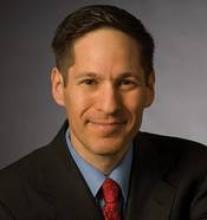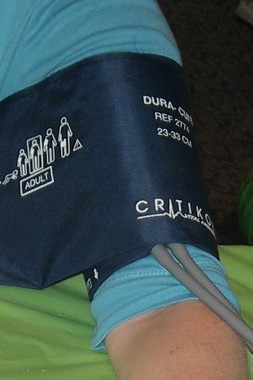User login
More than half of American adults with hypertension in the United States do not have their blood pressure under control, including many of those being treated for the condition, according to the Centers for Disease Control and Prevention.
Referring to uncontrolled blood pressure as "public health enemy No. 2" – second only to tobacco in the number of potentially preventable deaths associated with it annually – CDC director Thomas R. Frieden said that an estimated 66.9 million American adults had hypertension, defined as an average systolic blood pressure of 140 mm Hg or higher and an average diastolic blood pressure of 90 mm Hg or higher. The condition is deemed uncontrolled in approximately 35.8 million of them. Further, while an estimated 14.1 million of these adults were not aware of their hypertension, roughly 16 million were aware and receiving treatment for it; another 5.7 million were aware, but were not being treated, according to an analysis of data from the National Health and Nutrition Examination Survey 2003-2010.
"We’re talking about $131 billion in health care costs annually and 1,000 deaths/day, today and every day this year" that can be attributed to uncontrolled hypertension, which is a major risk factor for heart disease and stroke, Dr. Frieden stated in a media telebriefing.
"Nearly one quarter of the adults with uncontrolled hypertension in the survey had stage 2 disease [systolic blood pressure of 160 mm Hg or higher; diastolic of 100 mm Hg or higher], putting them at increased risk for both heart disease and stroke," he said.
According to the analysis of the data, reported in the Sept. 4 Morbidity and Mortality Weekly Report, the majority of adults with uncontrolled hypertension had a usual source of health care (89%), had received medical care in the previous year (88%), and had health insurance (85%). That said, the prevalence rates of uncontrolled hypertension were highest (93% and 87%, respectively) among those who reported receiving no medical care in the previous year and those without a usual source of health care. Additionally, of an estimated 14.1 million Medicare beneficiaries with hypertension, more than half (52%) did not have their blood pressure under control (MMWR 2012 Sept. 4 [61]:1-7).
"There are obviously a lot of missed opportunities for getting blood pressure under control. We [clinicians] know what to do, there are great medications that work well when taken as prescribed. We have to roll up our sleeves and make blood pressure control a priority at every visit," Dr. Frieden said. "We have to engage the entire health care team, including pharmacists, nurses, nutritionists, office staff to optimize patient support and follow-up care." He suggested tapping into electronic health records to track outcomes, streamlining prescription refills, and, most important, measuring and recording blood pressure at every visit and being aware of the numbers.
"We know that as many as one-third of the patients or more with multiple high blood pressure readings are not being diagnosed or treated," he said. "We have to increase provider and patient awareness."
In addition to improving recognition and diagnosis of hypertension through the use of team-based delivery models, other strategies for improving hypertension control in the clinical setting include increasing knowledge of and adherence to management guidelines, optimizing dosing and the use of effective combinations of antihypertensive medications, monitoring patients’ progress, encouraging patient self-monitoring of blood pressure, and educating and counseling patients about healthy lifestyle choices, Dr. Frieden explained, noting that such efforts can lead to dramatic and rapid improvements at the patient level as well as substantial public health improvements.
No conflicts of interest were disclosed.
More than half of American adults with hypertension in the United States do not have their blood pressure under control, including many of those being treated for the condition, according to the Centers for Disease Control and Prevention.
Referring to uncontrolled blood pressure as "public health enemy No. 2" – second only to tobacco in the number of potentially preventable deaths associated with it annually – CDC director Thomas R. Frieden said that an estimated 66.9 million American adults had hypertension, defined as an average systolic blood pressure of 140 mm Hg or higher and an average diastolic blood pressure of 90 mm Hg or higher. The condition is deemed uncontrolled in approximately 35.8 million of them. Further, while an estimated 14.1 million of these adults were not aware of their hypertension, roughly 16 million were aware and receiving treatment for it; another 5.7 million were aware, but were not being treated, according to an analysis of data from the National Health and Nutrition Examination Survey 2003-2010.
"We’re talking about $131 billion in health care costs annually and 1,000 deaths/day, today and every day this year" that can be attributed to uncontrolled hypertension, which is a major risk factor for heart disease and stroke, Dr. Frieden stated in a media telebriefing.
"Nearly one quarter of the adults with uncontrolled hypertension in the survey had stage 2 disease [systolic blood pressure of 160 mm Hg or higher; diastolic of 100 mm Hg or higher], putting them at increased risk for both heart disease and stroke," he said.
According to the analysis of the data, reported in the Sept. 4 Morbidity and Mortality Weekly Report, the majority of adults with uncontrolled hypertension had a usual source of health care (89%), had received medical care in the previous year (88%), and had health insurance (85%). That said, the prevalence rates of uncontrolled hypertension were highest (93% and 87%, respectively) among those who reported receiving no medical care in the previous year and those without a usual source of health care. Additionally, of an estimated 14.1 million Medicare beneficiaries with hypertension, more than half (52%) did not have their blood pressure under control (MMWR 2012 Sept. 4 [61]:1-7).
"There are obviously a lot of missed opportunities for getting blood pressure under control. We [clinicians] know what to do, there are great medications that work well when taken as prescribed. We have to roll up our sleeves and make blood pressure control a priority at every visit," Dr. Frieden said. "We have to engage the entire health care team, including pharmacists, nurses, nutritionists, office staff to optimize patient support and follow-up care." He suggested tapping into electronic health records to track outcomes, streamlining prescription refills, and, most important, measuring and recording blood pressure at every visit and being aware of the numbers.
"We know that as many as one-third of the patients or more with multiple high blood pressure readings are not being diagnosed or treated," he said. "We have to increase provider and patient awareness."
In addition to improving recognition and diagnosis of hypertension through the use of team-based delivery models, other strategies for improving hypertension control in the clinical setting include increasing knowledge of and adherence to management guidelines, optimizing dosing and the use of effective combinations of antihypertensive medications, monitoring patients’ progress, encouraging patient self-monitoring of blood pressure, and educating and counseling patients about healthy lifestyle choices, Dr. Frieden explained, noting that such efforts can lead to dramatic and rapid improvements at the patient level as well as substantial public health improvements.
No conflicts of interest were disclosed.
More than half of American adults with hypertension in the United States do not have their blood pressure under control, including many of those being treated for the condition, according to the Centers for Disease Control and Prevention.
Referring to uncontrolled blood pressure as "public health enemy No. 2" – second only to tobacco in the number of potentially preventable deaths associated with it annually – CDC director Thomas R. Frieden said that an estimated 66.9 million American adults had hypertension, defined as an average systolic blood pressure of 140 mm Hg or higher and an average diastolic blood pressure of 90 mm Hg or higher. The condition is deemed uncontrolled in approximately 35.8 million of them. Further, while an estimated 14.1 million of these adults were not aware of their hypertension, roughly 16 million were aware and receiving treatment for it; another 5.7 million were aware, but were not being treated, according to an analysis of data from the National Health and Nutrition Examination Survey 2003-2010.
"We’re talking about $131 billion in health care costs annually and 1,000 deaths/day, today and every day this year" that can be attributed to uncontrolled hypertension, which is a major risk factor for heart disease and stroke, Dr. Frieden stated in a media telebriefing.
"Nearly one quarter of the adults with uncontrolled hypertension in the survey had stage 2 disease [systolic blood pressure of 160 mm Hg or higher; diastolic of 100 mm Hg or higher], putting them at increased risk for both heart disease and stroke," he said.
According to the analysis of the data, reported in the Sept. 4 Morbidity and Mortality Weekly Report, the majority of adults with uncontrolled hypertension had a usual source of health care (89%), had received medical care in the previous year (88%), and had health insurance (85%). That said, the prevalence rates of uncontrolled hypertension were highest (93% and 87%, respectively) among those who reported receiving no medical care in the previous year and those without a usual source of health care. Additionally, of an estimated 14.1 million Medicare beneficiaries with hypertension, more than half (52%) did not have their blood pressure under control (MMWR 2012 Sept. 4 [61]:1-7).
"There are obviously a lot of missed opportunities for getting blood pressure under control. We [clinicians] know what to do, there are great medications that work well when taken as prescribed. We have to roll up our sleeves and make blood pressure control a priority at every visit," Dr. Frieden said. "We have to engage the entire health care team, including pharmacists, nurses, nutritionists, office staff to optimize patient support and follow-up care." He suggested tapping into electronic health records to track outcomes, streamlining prescription refills, and, most important, measuring and recording blood pressure at every visit and being aware of the numbers.
"We know that as many as one-third of the patients or more with multiple high blood pressure readings are not being diagnosed or treated," he said. "We have to increase provider and patient awareness."
In addition to improving recognition and diagnosis of hypertension through the use of team-based delivery models, other strategies for improving hypertension control in the clinical setting include increasing knowledge of and adherence to management guidelines, optimizing dosing and the use of effective combinations of antihypertensive medications, monitoring patients’ progress, encouraging patient self-monitoring of blood pressure, and educating and counseling patients about healthy lifestyle choices, Dr. Frieden explained, noting that such efforts can lead to dramatic and rapid improvements at the patient level as well as substantial public health improvements.
No conflicts of interest were disclosed.
FROM THE MORBIDITY AND MORTALITY WEEKLY REPORT
Major Finding: The prevalence of hypertension among U.S. adults in 2003-2010 was 30%. More than half (54%) of the estimated 66.9 million with high blood pressure did not have the condition under control.
Data Source: Data were from an analysis of the National Health and Nutrition Examination Survey 2003-2010 examining awareness and treatment of uncontrolled hypertension among U.S. adults with the condition.
Disclosures: No conflicts of interest were reported.


